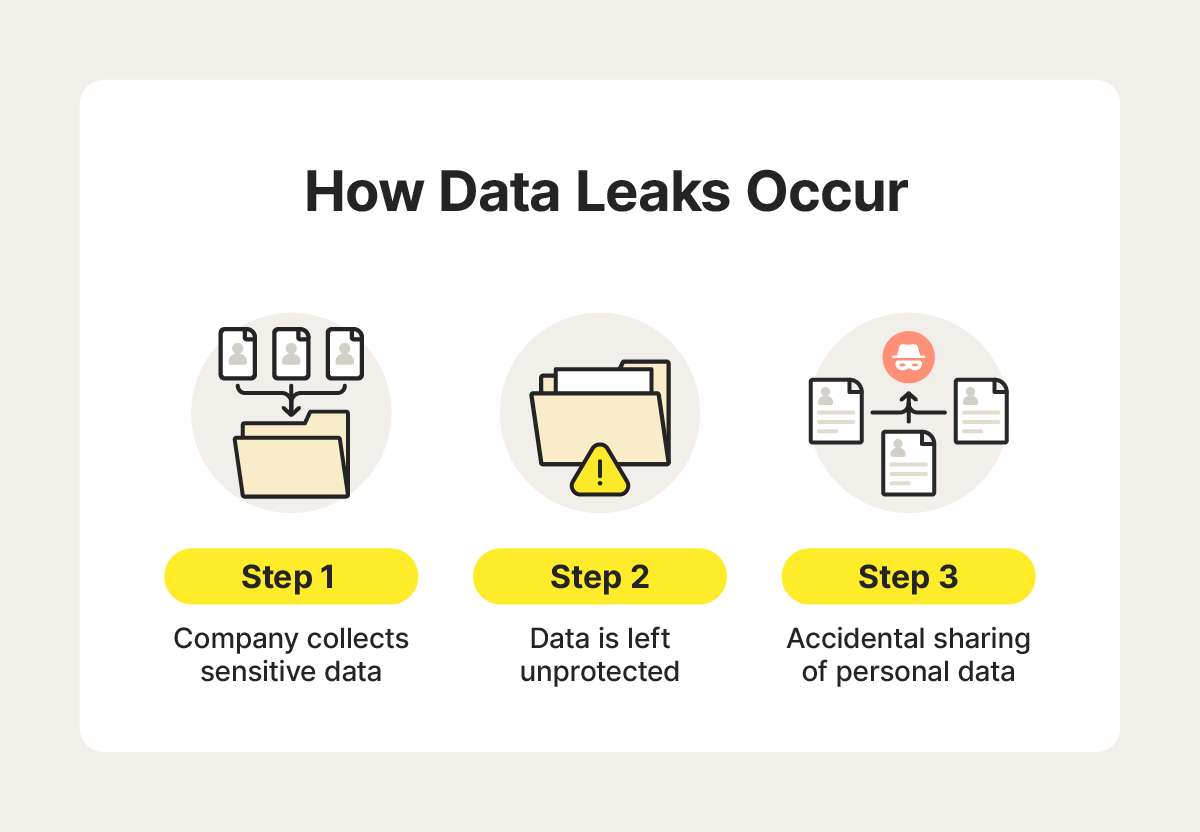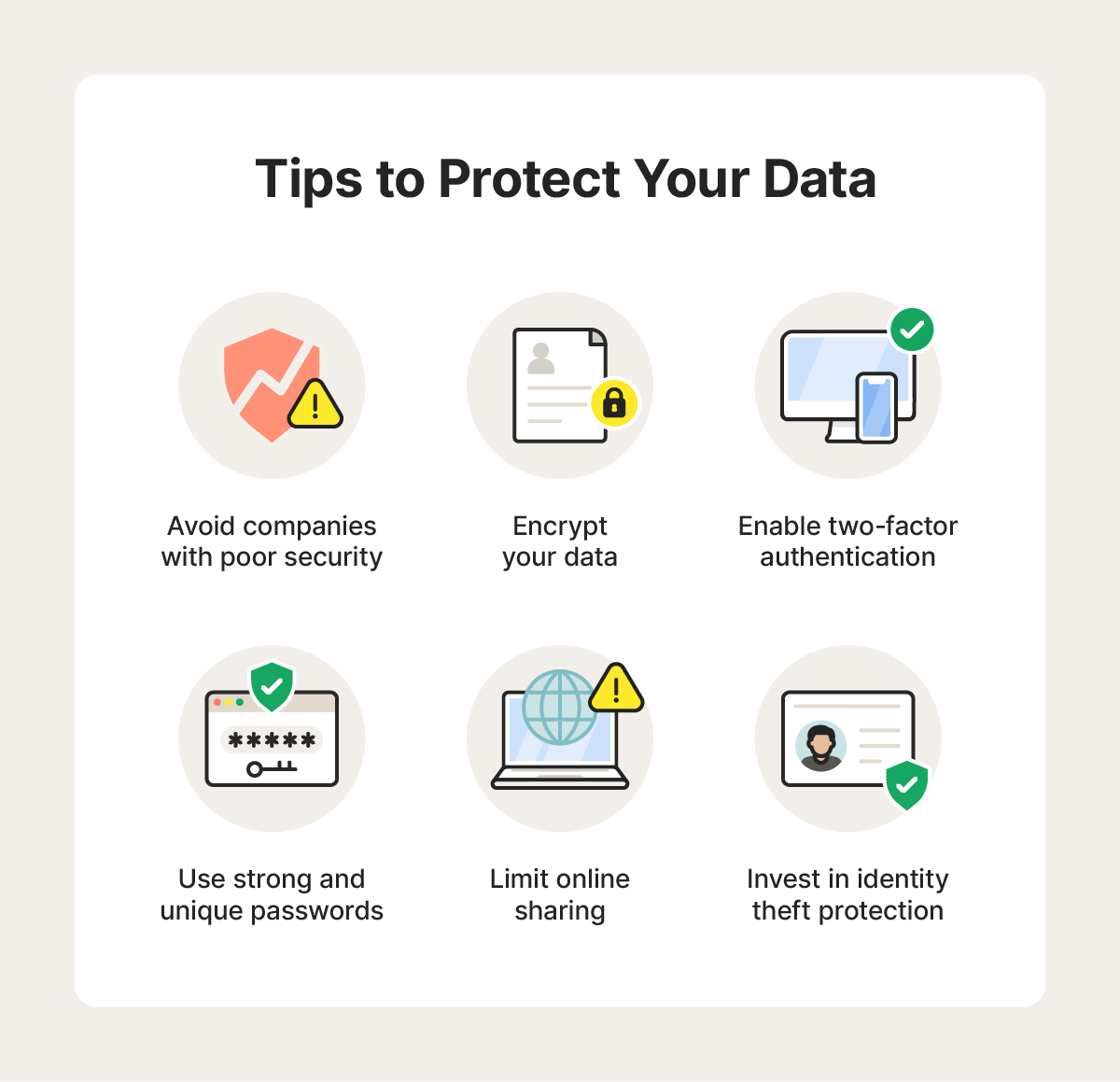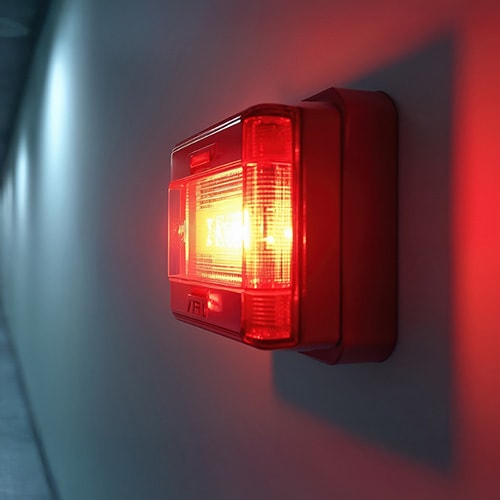Could your personal information have been exposed in a data leak? Data leaks happen when weak security practices or human errors cause an organization to unintentionally reveal private information. These leaks may lead to more serious problems including data breaches or identity theft.
Keep reading to learn about what causes data leaks, how to help protect your personal information, and what to do if your data has been leaked.
How does a data leak happen?
Data leaks happen when an organization accidentally exposes its customers’ or employees’ sensitive information. These leaks often stem from inadequate security practices or human error. Leaked information can lead to many negative outcomes, including identity theft.
Common causes of data leaks include the following:
- Poor security infrastructure: Outdated or poorly set up software systems can accidentally expose data, leading to leaks.
- Lost devices: If an unauthorized individual accesses a lost device with sensitive company information, it can lead to a data leak.
- Human error: Employees can make mistakes—such as sending an email to the wrong person, clicking a link in a phishing email, or failing to follow security protocols—that accidentally expose sensitive information.
- Software error or vulnerabilities: System errors can cause data leaks by accidentally granting open access to unauthorized users.


Data leak vs. data breach: What’s the difference?
People often use “data leak” and “data breach” interchangeably, but these terms refer to scenarios with important differences. Data leaks are when information is accidentally exposed due to internal mismanagement or errors. Data breaches involve a deliberate, unauthorized attempt by external actors to access confidential information.
Simply put, data leaks are typically accidents, while data breaches occur with malicious intent. However, data leaks can lead to breaches if attackers find and abuse the information exposed.


What information can cybercriminals obtain from data leaks?
Cybercriminals can use personal information exposed via data leaks—such as addresses and Social Security numbers—to commit identity theft, or profit by selling it on the dark web.
Here's a closer look at the type of information they target:
- Financial data: Criminals can exploit credit card numbers and bank account details to make unauthorized transactions or steal funds directly from accounts.
- Personal information: Hackers can use personal details like your name, Social Security number, and date of birth to commit identity theft and create fraudulent accounts.
- Login details: Cybercriminals can use stolen account credentials to access accounts with payment and other sensitive information, leading to identity theft and potential account lockout if they change the password.
How to help prevent data leaks and protect your information
Companies and organizations can help prevent data leaks by following security best practices, regularly conducting security audits, and providing employee cybersecurity training. However, even with these strategies in place, mistakes happen. Once your data is stored elsewhere, there is little you can do to prevent it from being caught in a data leak.


One of the most important protective measures you can take is to be careful about which companies you share personal information with. Then, take additional steps to help safeguard your sensitive data and protect against identity theft if a leak occurs:
- Avoid companies with poor security: To lower the risk of your data being leaked, avoid sharing it with companies that have poor security records or a history of breaches. Companies with solid security practices often publish security audits and maintain strict data usage policies.
- Encrypt your data: Data encryption converts your information into unreadable code, making it useless if intercepted without the decryption key. To safeguard your data, use a VPN when connecting to unsecured Wi-Fi, and choose cloud storage providers that offer built-in encryption.
- Enable two-factor authentication: Two-factor authentication provides additional security by requiring both a password and a second verification step, like a one-time code, to access your accounts and data.
- Use strong and unique passwords: Use a strong and unique password to help prevent hackers from accessing your accounts easily. Using a unique password for every account helps prevent cybercriminals from accessing all your accounts if one of your passwords gets leaked.
- Limit the personal information you share online: Avoid oversharing on social media, and set your accounts to private. Even seemingly harmless posts, like birthday announcements, can give hackers clues for guessing security questions or stealing your identity. The less information you share online, the less data there is that can leak.
- Invest in identity theft protection: Working alone to protect your data can feel nearly impossible. That’s where identity theft protection services come in. LifeLock Standard offers powerful identity protection and a suite of features to help secure your finances, credit, and reputation should the worst ever happen.
What to do if your data has been leaked
Discovering that your personal information may be accessible to cybercriminals can feel overwhelming. Thankfully you can take steps to minimize the damage and help protect against the abuse of your data if it does leak.
Here’s how to help mitigate the damage of a data leak:
- Change your passwords: Update your passwords on all impacted accounts. Ensure you're using a long, strong, and unique password on each account. And get a password manager to easily create and store secure passwords without having to remember them all.
- Monitor your financial accounts: Regularly reviewing your financial accounts is a crucial security measure, especially after a data leak. Monitor your credit card statements, bank accounts, and any other accounts that store financial information. If you spot any suspicious activity or unauthorized purchases, report them right away.
- Freeze your credit: A credit freeze helps prevent anyone (including lenders) from accessing your credit report. This can reduce the likelihood of criminals opening new accounts in your name, since lenders typically need to review credit reports before offering credit.
Real-world data leak examples
Despite companies collectively spending billions on cybersecurity every year, data leaks still happen. Let's take a look at some recent real-world data leak examples to see how they impacted those involved.
- Digital Pix & Composites: In 2024, it was discovered that Digital Pix & Composites, a graduation photography company, accidentally leaked 469 text files with personal details of over 43,000 students from 222 U.S. universities.
- Microsoft Power Apps: In 2021, some U.S. corporations and government agencies using Microsoft Power Apps experienced a data leak due to default configuration issues. This mistake left 38 million records exposed, including data on coronavirus tracing, vaccination data, and job applicant information with Social Security numbers.
Help protect your data with LifeLock
With so much information stored digitally, data leaks are inevitable. That's why it's important to invest in protection like LifeLock Standard, which can help you stay a step ahead by scouring the dark web and notifying you if your information is found. Plus, LifeLock monitors people-search sites and other areas of the web for potentially fraudulent use of your Social Security number, date of birth, or other personal information.
Subscribe to LifeLock today and join millions of people who already trust LifeLock to protect their identity.
FAQs about data leaks
Still have questions about data leaks? Here's what you need to know.
How do you know if your data has been leaked?
You can use a breach detection tool to check if your personal info has been leaked on the dark web. Identity protection tools like LifeLock Standard can also help monitor the dark web, people-search sites, and other areas of the web on an ongoing basis and notify you if your data appears.
What happens if your data gets leaked?
If your data gets leaked, it means a fraudster could potentially use it for illicit gain or sell it for other criminals to use. Take steps to protect your identity by monitoring your financial accounts, updating your passwords, and potentially freezing your credit.
Editor’s note: Our articles provide educational information. LifeLock offerings may not cover or protect against every type of crime, fraud, or threat we write about.
This article contains
- How does a data leak happen?
- Data leak vs. data breach: What’s the difference?
- What information can cybercriminals obtain from data leaks?
- How to help prevent data leaks and protect your information
- What to do if your data has been leaked
- Real-world data leak examples
- Help protect your data with LifeLock
- FAQs about data leaks
Start your protection,
enroll in minutes.
LifeLock is part of Gen – a global company with a family of trusted brands.
Copyright © 2025 Gen Digital Inc. All rights reserved. Gen trademarks or registered trademarks are property of Gen Digital Inc. or its affiliates. Firefox is a trademark of Mozilla Foundation. Android, Google Chrome, Google Play and the Google Play logo are trademarks of Google, LLC. Mac, iPhone, iPad, Apple and the Apple logo are trademarks of Apple Inc., registered in the U.S. and other countries. App Store is a service mark of Apple Inc. Alexa and all related logos are trademarks of Amazon.com, Inc. or its affiliates. Microsoft and the Window logo are trademarks of Microsoft Corporation in the U.S. and other countries. The Android robot is reproduced or modified from work created and shared by Google and used according to terms described in the Creative Commons 3.0 Attribution License. Other names may be trademarks of their respective owners.





